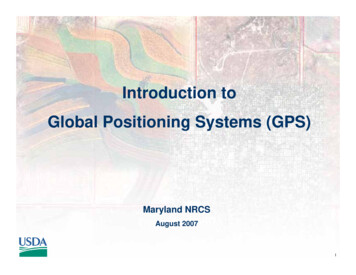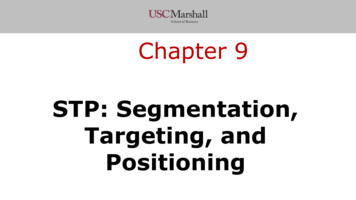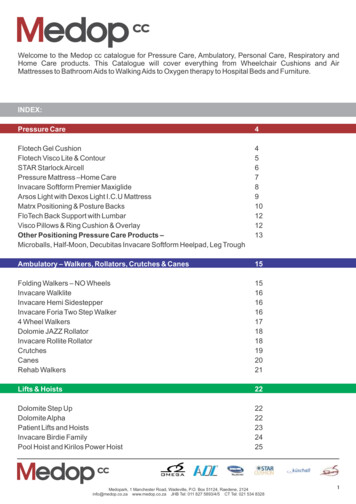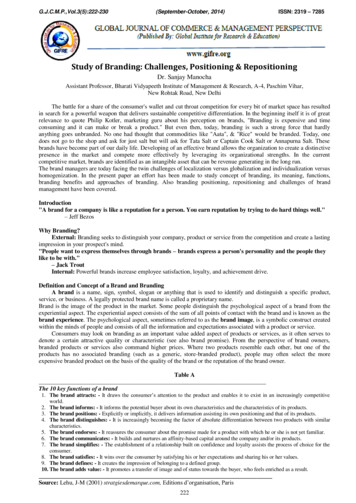
Transcription
Introduction toGlobal Positioning Systems (GPS)Maryland NRCSPreparedUSDAAugustfor20071
Topics GPS function & terminology GPS applications in NRCS Garmin GPS 76 for Data Collection2
I. What is GPS?GPS is a positioning system based on a network of satellites that continuouslytransmit coded information. The information transmitted from the satellites can beinterpreted by receivers to precisely identify locations on earth by measuringdistances from the satellites.GPS is funded by and controlled by the U.S. Department of Defense (DOD). Thesystem is called NAVSTAR.¾Precisely identify locations on earth bymeasuring distances from the satellites¾ NAVSTAR –Navigational Satellite Timing And Ranging3
Three Components to GPSSpace Segment -thesatellites orbiting theearth and transmittingtiming and rangingmessagesControl Segment monitors the healthand position of thesatellites in thespace segment andtransmits correctioninformation back upto the satellitesUser Segment - the handheld or other receivers usedto interpret the messagesbroadcast from thesatellites4
GPS Constellation The nominal GPS Operational Constellation consists of roughly 24satellites. Each satellite has a number on your GPS screen. Newersatellites have been sent up to replace older ones. The GPS signal communicates information about the precise position of thesatellite and the precise time of the signal. Each satellite orbits the earth in about 12 hours. The satellite orbits repeatroughly the same ground track each day. Learn to identify the time of daywhen satellite coverage is best in your area and plan your field workaccordingly.Source: Peter H. Dana, The University of Colorado. /gps f.html5
2-D and 3-D PositioningSince we exist in threedimensions, theoretically weneed to get our distance fromthree satellites. The scenarioabove is theoretical because itsupposes that we know exactlyhow far we are from thesatellites. In order to get our GPSclock in synch with the satelliteclocks, we need to get data froma fourth satellite to calculate thetime offset and set our GPS clockto near perfect system time.Bottom line:You need at least 3 satellites toget a 2-Dimensional position and4 satellites to get a 3-D position.6
Sources of Error that decrease the accuracy of your GPS readings Number and geometry of satellites visible Signal multi-path Orbital and Satellite Clock errors Ionosphere and troposphere delays Receiver clock errorsGPS position is not perfect . Some errors you have some control over. As a GPSuser, you have some control over the first type of error - you can wait for thesatellites to move into better geometry or plan your data collection for a good timeof day. You cannot control multi-path error, but you do need to recognize when itmay occur and pay close attention to the measurements that you are taking.Orbital and Satellite Clock errors as well as atmospheric delays are invisible toyou, but you can avoid them by using differential correction. There is nothing thatyou can do about your receiver clock errors. GPS receivers will generally reportan estimate of the accuracy of the position being reported by the unit at the time.7
DGPSDifferential Global Positioning Systems DGPS improves the accuracy and integrity of standard GPS DGPS works by placing a GPS receiver at a known location,this is called a reference station The reference station knows its exact location, and thereforecan calculate the difference between the GPS derivedpositions and the true position.The reference station calculates the errors in the GPS signals by comparing its knownposition to the position derived from the satellite signals. The stations actually calculate thedifferences between measured and actual ranges for each of the satellites visible from thatstation. This calculated difference is called the “differential correction” for that satellite. In realtime DGPS, the correction signals are broadcast from the reference station and usedimmediately by the roving GPS to correct the position data being collected. There are twomain sources of real time DGPS that USDA uses.8
NDGPSNationwide Differential Global Positioning SystemThe Coast Guard operates a network of reference stations known as theCoast Guard Maritime Differential GPS Service as well as the developingNationwide DGPS service.The type of frequency that the NDGPS uses is “ground following”, meaningthat it will not be blocked by most terrain features in its operating range. Thismeans that the GPS user does not need to have a clear line of site to theDGPS transmitter. GPS users can use this signal if they have specializedreceivers like the MBX-3 that is included in the USDA GPS configuration 1.9
NDGPSNationwide Differential Global Positioning SystemPSGGPS SiCoast Guard basegnalstation and differentialtransmitteralgnSiMobile GPS unitls i gn anoitecl corraitnrel timeaeDiffernsent iKnown Position10
Wide Area Augmentation System(WAAS)WAAS is a DGPS system implemented by the Federal Aviation Administrationand designed primarily for aviation users. The system uses 25 ground referencestations to generate a nation-wide correction message. This message is thenuploaded to two geo-synchronous satellites. The WAAS satellites then beam thecorrection message back to GPS users on the L1 frequency, the same frequencythat the GPS signal is broadcast on.The target accuracy of this system is 7 meters horizontal and vertical, testing hasfound it to be in the 3-5 meter range.WAAS has some serious limitations for users on the ground because the L1frequency is “line of sight”, meaning that it can be blocked by terrain, buildings,etc.11
Wide Area Augmentation System(WAAS)GPS SatellitesWAAS SatellitentferefiDirectroial CalignSonMobile GPS unit12
GPS Error NOT Addressed by DGPS Poor Satellite Geometry Poor Satellite Visibility Multipath Interference13
GPS Error NOT Addressed by DGPS DGPS can eliminate some errors that were discussed in the last slidebut not all of them. Satellites that are bunched in the sky will give a less accurate positionthan if those satellites were more evenly distributed in the sky. If the satellites are hidden by trees, buildings etc then they can not beused to determine position. As you gain experience, you will get an idea of where satellites are inthe sky at different times of the day. This will help you to plan when toget GPS data in difficult areas. The signal can be bounced around by buildings and other flat reflectivesurfaces. This can cause some error because a bouncing signal willtake longer to get to you and will therefore tell you that the satellite isfarther away than it really is. This is called multipath interference andyou just need to be aware that it exists.14
Accuracy varies by type of GPS unit Standard GPS - 15 m horizontal (50 ft) NDGPS - 5 m horizontal (16 ft) WAAS - 3 m horizontal (10 ft) in tests15
II. GPS Applications in NRCS Determine 3-Dimensional Positions Measure Lengths/Distances Measure Areas Navigation GPS Mapping16
II. GPS Applications in NRCSGPS allows the user to obtain, record and manipulate precise positions on theface of the earth. This basic functionality can be used to accomplish the coretasks listed in the previous screen.Determining positions means that you obtain their geographic coordinates.Lengths and areas can be measured if end points of a line or the corners of afield are obtained with a GPS.If you know the coordinates of your destination, then the GPS can show you thedistance and direction to that point.GPS position measurement relies on very precise time measurement. Becauseof that, the general GPS user can tell time with near atomic clock accuracy.17
The key function of GPS to locate your position on the EarthBarn LocationLatitude39.5673 NLongitude115.345 WGPS allows us to obtain, record and manipulatepositions on the earth.A waypoint gives us the coordinates for a singlepoint location.Waypoints and tracks give us a digital record in theform of a geospatial layer that we can print to a map(ex. planned practice, structure, resource layer)GIS tools allow us to discern relationships andmeasure distances between points.18
GPS can be used to measure distancesWaypointPoint to Point Distance 200 ftTrackLength of Berm 350 ftTracks are a collections of points collectedautomatically by the unit. For example, theGPS can record track points every 10 secondsas you walk the perimeter of a field. Thecollection method can also be set to distance,i.e. collect a point every 5 feet. Garmin alsohas an automated mode that takes intoaccount speed of travel and direction changes.The length of a track is calculated as thecumulative length between each track point.19
GPS can be used to measure areasJust like lengths, areas can be measured using points ortracks.Points can be used to define the area of regularly shapedareas that have well defined corners. A shape withcurving edges, like a circular field or a field bounded by ameandering stream, will be harder to define using pointsthat you determine in the field.Tracks are very good at capturing curving lines as youtravel around those edges. The downside is that a trackwill follow your every move.20
Navigation with entwopoints#Start###21
RoutesA route is an ordered set of waypoints that represents the pathbetween two locations.The solid line on the slide shows an example of the straight linebetween the points labeled start and the finish.A route allows you to set intermediate waypoints on your path from Ato B that take into account terrain, roads or other relevant factors.The GPS will report the length of the entire route as well as thelengths of each of the segments between waypoints.22
GPS MappingGPS data can be used to map point, line and area features.Examples of these features are:Points - grain bins, utility poles, range monitoring sites, culturalresource areas,Lines - roads/trails, streams, pipelines, fencesAreas - fields, wetlands, pondsIn general, and on the GPS units that USDA is acquiring, there is amethod to attribute data that you collect in the field. That means thatyou can give unique symbols and names to the data that you collectso that you can interpret it back in the office. For example, you willbe able to distinguish between points collected for a field boundaryand those collected to map a grain bin.23
GPS Mapping########### # ############### ################## #### # ###############The data collected using GPS can be used to make maps of naturalresources, physical infrastructure or any other geographic features.In the slide the field is an area defined by 4 corner points, the road isa line, the lake is and area defined by a series of points.24
III. Data CollectionGarmin GPSMap 76
Required Accuracy LevelsUSE THE DGPS BEACON TO ACHIEVE GREATEST ACCURACYDGPS Beacon Receiver Accuracy should be less than or equal to 10 ft.Use for: Certifying Conservation PracticesStand-Alone GPS Accuracy should be less than or equal to 20 ft.Use for: Basic Conservation PlanningResource InventoriesNavigation26
Layout and Button Functions ofthe Garmin GPSMap76AntennaZoom OutNavPowerQuitZoom InPageMenuEnterScreen27
Back of the unitAntenna CablePortBatteryCompartmentPower/DataPortOpen the battery compartment by turning the steel D-ring 1/4 turn counterclockwise and then pulling straight away from the unit.28
Turning on the Map76Turn on the GPS by pressingand holding the power key.Move through the introductoryscreen by pressing the Pagekey.29
Setting the Map76 to SimulatorModeYou will want to set theMap76 to simulator mode any time you have theGPS unit powered up inside. This save batteries by not powering theantenna, it also prevents you from getting messages telling you that theunit can not see any satellites.30
Pages on the Map76The Page and Quit keys areused to navigate betweenthe pages.31
GPS Information PageReceiver StatusMessageSky MapSatellite StrengthIndicator BarsPosition32
Main Menu33
Interface SetupStand-Alone GPSBackpack - DGPS34
Backpack – DGPS Beacon ReceiverSet the “Beacon” field to User and then set the Frequency and bit rate for the NDGPSstation that you want to use. This is often more effective and predictable than the Scansetting. Baud rate setting is a parameter of the communication between the GPS andthe Beacon receiver and can not be adjusted by the user on this screen.35
Note AccuracyAccuracy36
Mark A WaypointA waypoint is the coordinate definition of a position stored onthe GPS.To mark a waypoint:Press and hold the Enter key (also called the Mark key) untilthe waypoint dialog box appears on your screen. Use theRocker key to highlight the name field, located on the top rightof the dialog box. Press Enter to begin editing the waypointname. Waypoint names can be up to 10 characters long. Thecharacters for each field are selected one at a time using upand down on the rocker key. Press enter to accept a name forthe point.Waypoints are automatically saved when you press the Mark button. Pressing theQuit button before the waypoint information is edited will prevent the waypointfrom staying in the memory. Otherwise, if you find that you have created awaypoint that you do not want, select the delete button on the waypoint screenand press enter. The GPS unit will ask you for a confirmation before it deletes thewaypoint.37
Using the Averaging FunctionThe averaging function can be used to reduce the inaccuracy ofwaypoints. To use averaging, start marking a point like you wouldnormally. Before naming the point or accepting it, press the Menukey. Press Enter to accept “Average Location.”Keep the GPS antenna in thesame place!Once the accuracy has stabilized, pressEnter to return to the waypoint page.Highlight “OK” and press Enter to save thewaypoint.38
The End39
Learn to identify the time of day . 8 DGPS Differential Global Positioning Systems . 21 # # # # # # # Navigation with GPS Straight line between two points Route between two points Finish Start. 22 Routes A route is an ordered set of











